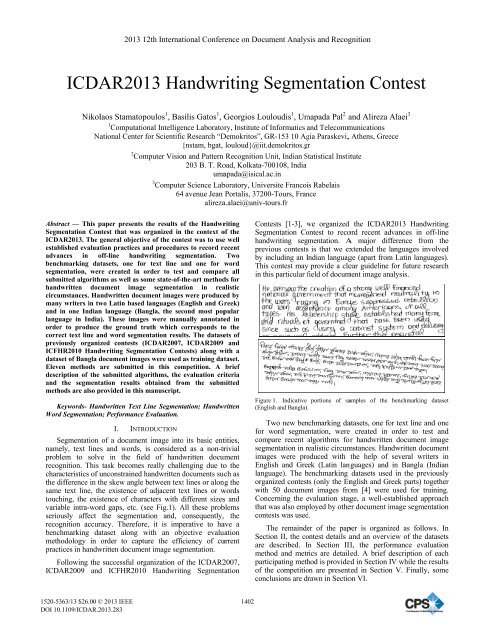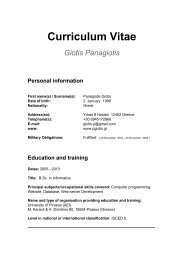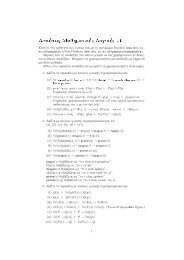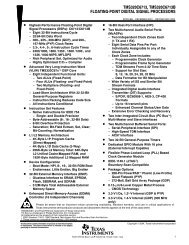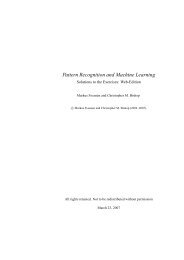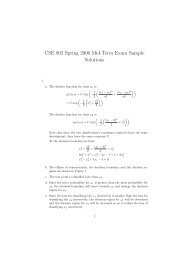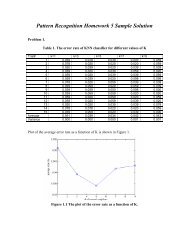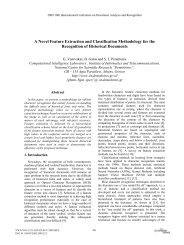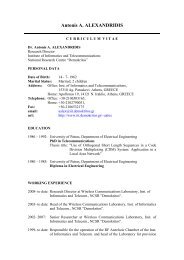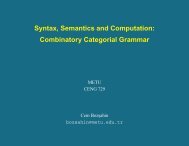ICDAR 2013 Handwriting Segmentation Contest
ICDAR 2013 Handwriting Segmentation Contest
ICDAR 2013 Handwriting Segmentation Contest
Create successful ePaper yourself
Turn your PDF publications into a flip-book with our unique Google optimized e-Paper software.
<strong>2013</strong> 12th International Conference on Document Analysis and Recognition<br />
<strong>ICDAR</strong><strong>2013</strong> <strong>Handwriting</strong> Segme<br />
entation <strong>Contest</strong><br />
Nikolaos Stamatopoulos 1 , Basilis Gatos 1 , Georgios Louloudis 1 , Umapada Pal 2 and Alireza Alaei 3<br />
1 Computational Intelligence Laboratory, Institute of Informatics and Telecommunications<br />
National Center<br />
for Scientificc Research “Demokritos”, GR-153 10 Agia Paraskevi, , Athens, Greece<br />
{nstam, bgat, louloud}@iit.demokritos.gr<br />
2 Computer Vision and Pattern Recognition Unit, Indian Statistical S Institute<br />
203 B. T. Road, Kolkata-700108, India<br />
umapada@isical.<br />
.ac.in<br />
3 Computer Science Laboratory, Universite Francois Rabelais<br />
64<br />
avenue Jean Portalis, 37200-Tours, France<br />
alireza.alaei@univ-tours.fr<br />
Abstract — This paper presentss the results of o the <strong>Handwriting</strong><br />
<strong>Segmentation</strong> <strong>Contest</strong> that was organized in the context of the<br />
<strong>ICDAR</strong><strong>2013</strong>. The general objective of the contest was to usee well<br />
established evaluation practices and procedures to record recent<br />
advances in off-line handwriting<br />
segmentation.<br />
Two<br />
benchmarking datasets, one for text line and a one for word<br />
segmentation, were created in order to testt and compare all<br />
submitted algorithms as well as some state-of-the-art methods for<br />
handwritten<br />
document<br />
image<br />
segmentation in realistic<br />
circumstances. Handwritten document imagess were produced by<br />
many writers in two Latin based<br />
languages (English and Greek)<br />
and in one Indiann language (Bangla, the second most popular<br />
language in India). These images were manually annotated in<br />
order to produce the ground truth which corresponds c<br />
too the<br />
correct text line and word segmentation results. The datasets of<br />
previously organized contests (<strong>ICDAR</strong>2007, <strong>ICDAR</strong>2009 and<br />
ICFHR2010 <strong>Handwriting</strong> <strong>Segmentation</strong> <strong>Contest</strong>s) along with a<br />
dataset of Bangla document images were used as training dataset.<br />
Eleven methods are submitted<br />
in this competition. A brief<br />
description of the submitted algorithms, the evaluation criteria<br />
and the segmentation results obtained from the submitted<br />
methods are also provided in this<br />
manuscript.<br />
Keywords- Handwritten Text Line <strong>Segmentation</strong>; Handwritten<br />
Word<br />
<strong>Segmentation</strong>; Performancee Evaluation.<br />
I. INTRODUCTION<br />
<strong>Segmentation</strong><br />
of a document image into<br />
its basic entities,<br />
namely, text lines and words, is considered as a non-trivial<br />
problem to solve in the field of handwritten document<br />
recognition. This task becomes really challenging due too the<br />
characteristics of unconstrained<br />
handwritten documents such as<br />
the difference in the skew angle<br />
between textt lines or along the<br />
same<br />
text line, the existence of adjacent text lines or words<br />
touching, the existence of characters with different sizess and<br />
variable intra-word gaps, etc. (see Fig.1). All these problems<br />
seriously affect the segmentation and, consequently,<br />
c , the<br />
recognition accuracy. Therefore, it is imperative to have a<br />
benchmarking dataset along with an objective evaluation<br />
methodology in order to capture the efficiency of current<br />
practices in handwritten document image segmentation.<br />
Following the successful organization off the <strong>ICDAR</strong>2007,<br />
<strong>ICDAR</strong>2009 and<br />
ICFHR2010 <strong>Handwriting</strong> <strong>Segmentation</strong><br />
<strong>Contest</strong>s [1-3], we w organized d the <strong>ICDAR</strong><strong>2013</strong> <strong>Handwriting</strong><br />
<strong>Segmentation</strong> <strong>Contest</strong> to record recent advances in off-line<br />
handwriting segmentation. A major difference from<br />
the<br />
previous contests is that we extended the languages involved<br />
by including an Indian language (apart from<br />
Latin languages).<br />
This<br />
contest may provide a clear guideline for future research<br />
in this particular field f of document image analysis.<br />
Figure 1. Indicative portions of samples of the benchmarking dataset<br />
(English and Bangla).<br />
Two new benchmarking datasets, one for text line and<br />
one<br />
for word segmentation, weree created in order to testt and<br />
compare recent algorithms a for<br />
handwrittenn document image<br />
segmentation in realistic circumstances. Handwritten document<br />
images were produced with the help of several writers in<br />
English and Greek (Latin languages) and in Bangla (Indian<br />
language). The benchmarking<br />
datasets used<br />
in the previously<br />
organized contests (only the English and Greek parts) together<br />
with<br />
50 document images from [4] were used for training.<br />
Concerning the evaluation e stage, a well-established approach<br />
that was also employed by other document image segmentation<br />
contests was used.<br />
The remainder of the paper is organized as follows. In<br />
Section II, the contest details and an overview of the datasets<br />
are described. Inn Section III, the performance evaluation<br />
method and metrics are detailed. A brief description of<br />
each<br />
participating method is provided in Section IV I while the results<br />
of the competition are presented in Section<br />
V. Finally, some<br />
conclusions are drawn in Section VI.<br />
1520-5363/13 $26.00 © <strong>2013</strong> IEEE<br />
DOI 10.1109/<strong>ICDAR</strong>.<strong>2013</strong>.283<br />
1434 1402
II.<br />
THE CONTEST<br />
The authors of candidate methods registered their interest in<br />
the contest and downloaded the training dataset (150 document<br />
images written in English and Greek as well as 50 images<br />
written in Bangla along with the associated ground truth) and<br />
the corresponding evaluation software [5]. At a next step, all<br />
the participants registered for the contest were asked to submit<br />
two executables: one for text line segmentation and one for<br />
word segmentation. Both the ground truth and the result<br />
information were raw data image files with zeros<br />
corresponding to the background and positive integer values<br />
each corresponding to a segmentation region. After the<br />
evaluation of all candidate methods, the benchmarking dataset<br />
(50 images written in English, 50 images written in Greek and<br />
50 images written in Bangla) (see Fig.1) along with the<br />
evaluation software became publicly available [6].<br />
The training and benchmarking datasets contain black &<br />
white handwritten document images produced by many writers.<br />
The corresponding document images do not include any nontext<br />
elements (lines, drawings, etc.). During the creation phase<br />
of the Latin part of the benchmarking dataset, 50 writers were<br />
asked to copy two samples of text in English and Greek<br />
language. For the Indian part, 50 document images with<br />
different content and sizes were considered.<br />
III. PERFORMANCE EVALUATION<br />
The method used to evaluate the performance of the<br />
submitted algorithms is based on counting the number of<br />
matches between the entities detected by the algorithm and the<br />
entities in the ground truth [7]. For the detection of matches,<br />
we used a MatchScore table whose values are calculated<br />
according to the intersection of the ON pixel sets of the result<br />
and the ground truth.<br />
Let I be the set of all image points, G j the set of all points<br />
inside the j ground truth region, R i the set of all points inside<br />
the i result region, T(s) a function that counts the points of set s.<br />
Table MatchScore(i,j) represents the matching results of the j<br />
ground truth region and the i result region:<br />
T( Gj<br />
Ri<br />
I<br />
)<br />
MatchScore (, i j)<br />
<br />
T( ( Gj<br />
Ri) I ) (1)<br />
A region pair is considered as a one-to-one match only if<br />
the matching score is equal to or above the evaluator's<br />
acceptance threshold T a . Let N be the count of ground-truth<br />
elements, M be the count of result elements, and o2o be the<br />
number of one-to-one matches, the detection rate (DR) and<br />
recognition accuracy (RA) are defined as follows:<br />
o2o<br />
o2o<br />
DR , RA <br />
N M<br />
(2)<br />
A performance metric FM can be extracted if we combine<br />
the values of detection rate (DR) and recognition accuracy<br />
(RA):<br />
2DR RA<br />
FM <br />
DR RA<br />
(3)<br />
A global performance metric SM for handwriting<br />
segmentation is extracted by calculating the average values of<br />
the FM metric for text line and word segmentation. The<br />
performance evaluation method is robust and well established<br />
since it has been used in other contests [1-3] and it depends<br />
only on the selection of the acceptance threshold T a .<br />
IV. METHODS AND PARTICIPANTS<br />
Nine research groups participated in the competition with<br />
eleven different algorithms (two participants submitted two<br />
algorithms each). Nine submissions included both text line and<br />
word segmentation algorithms while two submissions included<br />
only a text line segmentation method. Brief descriptions of the<br />
methods are given in this section.<br />
CUBS method: Submitted by Z. Shi, S. Setlur and V.<br />
Govindaraju from the Center for Unified Biometrics and<br />
Sensors (CUBS), University at Buffalo, SUNY, New York,<br />
USA. Both text line and word segmentation methods are based<br />
on a connectivity mapping using directional run-length analysis<br />
[8, 9]. A handwritten document image is firstly mapped into a<br />
connectivity map which reveals the text line patterns, from<br />
which the text lines are extracted. For word segmentation, a<br />
different parameter is used to show word-like primitives in the<br />
map. At a next step, the distances between consecutive word<br />
primitives are computed using the convex hull distance. A bimodal<br />
fitting is applied to find the threshold in determining the<br />
minimal word gap in the document image.<br />
GOLESTAN method (two methods): Submitted by M.<br />
Ziaratban from the Electrical Engineering Department,<br />
Golestan University in Iran.<br />
a. In the text line extraction algorithm, a handwritten text<br />
image is first filtered by a 2D Gaussian filter. The size and the<br />
standard deviation of the Gaussian filter as well as the block<br />
size are calculated for each text image, separately. The filtered<br />
image is then divided into a number of overlapped blocks. For<br />
each block, a local skew angle is estimated. The filtered block<br />
is binarized using an adaptive threshold and with respect to the<br />
estimated local skew angle. Binarized blocks are concatenated<br />
to get the overall path of text lines. Finally, the text lines are<br />
extracted by thinning the background of the path image. A<br />
similar approach is used to extract words from each text line. A<br />
detected text line is first filtered by a 2D Gaussian filter. At a<br />
next step, ascenders and descenders are then eliminated and an<br />
adaptive thresholding is used to determine the words.<br />
b. Line segmentation method remains the same while for the<br />
word segmentation a 2D Gaussian filter is used in the same<br />
way without eliminating the ascenders and descenders.<br />
INMC method: Submitted by J. Ryu and N.I. Cho from the<br />
INMC, Department of Electrical Engineering and Computer<br />
Science, Seoul National University, Korea and H.I. Koo from<br />
the Ajou University, Suwon, Korea. The line segmentation<br />
algorithm is based on an energy minimization framework<br />
considering the fitting errors of text lines and the distances<br />
between detected text lines [10]. However, the state-estimation<br />
was improved by performing over-segmentation at the initial<br />
stage. Therefore, unlike [10], the algorithm is able to handle<br />
cursive and Indian scripts where many graphemes are<br />
connected. The energy minimization algorithm is also<br />
improved by developing additional steps based on dynamic<br />
programming. Concerning the word segmentation, method [11]<br />
1435 1403
is modified in order to deal with the irregularity in handwriting<br />
documents. A text line is segmented into words using the<br />
statistical information of spacing in each text-line and then,<br />
based on the local statistical information of word segments, a<br />
refining is applied.<br />
LRDE method: Submitted by E. Carlinet and T. Géraud from<br />
the EPITA Research and Development Laboratory (LRDE) in<br />
Le Kremlin-Bicetre, France. For text line segmentation, the<br />
inter-line spacing is first detected using a correlation measure<br />
of the projected histogram of the image on the y-axis. The<br />
input image is sub-sampled in both dimensions while turning it<br />
into a gray-level image. Then, an anisotropic Gaussian filtering<br />
is applied (mainly horizontal) whose kernel support depends on<br />
the inter-line spacing detected above. The morphological<br />
watershed transform is computed, leading into partitioning the<br />
image into regions. To obtain line segmentation, a simple<br />
merging procedure is applied on the region adjacency graph.<br />
Word segmentation relies on the text lines detected above to<br />
compute the inter-word spacing. The horizontal distances<br />
between each pair of adjacent connected component of a text<br />
line give the intra-word and inter-word spaces. A 2-means<br />
clustering allows setting a decision boundary between the two<br />
classes. At a next step, dilation is performed with a horizontal<br />
structuring element whose width depends on inter-word<br />
spacing detected above. Finally, an attribute morphological<br />
closing followed by a morphological watershed transform<br />
produces the final word segmentation result.<br />
MSHK method: Submitted by L. Mengyang from the<br />
Department of Management Sciences, City University of Hong<br />
Kong. The text line segmentation algorithm is based on<br />
connected component analysis. The average width and height<br />
of connected components (CCs) are first estimated using<br />
statistical metrics methods. The CCs of normal size that are<br />
close to each other and almost at the same latitude are grouped<br />
into short text lines. At a next step, the previously detected text<br />
lines are merged into long text lines according to their<br />
direction, latitude and the intersections between them. Finally,<br />
the CCs with abnormal size are merged with the existing text<br />
lines by checking the neighborhood. Once the text lines are<br />
detected, the horizontal density of each text line is estimated<br />
and a closing operation is applied according to it. Finally, the<br />
average distance between adjacent words is calculated and is<br />
used to merge adjacent words whose distances are smaller than<br />
this value.<br />
NUS method: Submitted by X. Zhang and C. L. Tan from the<br />
School of Computing at the National University of Singapore.<br />
For text line extraction, all small strokes and large connected<br />
components (CCs) are first removed and a skew correction<br />
method is applied. The possible locations of the text lines are<br />
detected using a seam carving algorithm. When constructing<br />
the energy accumulation matrix, the accumulative energies are<br />
normalized by their distance to the current position using only<br />
the newest W/2 energies, where W is the width of the image.<br />
Seams with an energy value smaller than a threshold are<br />
removed and for each remaining seam the CCs which are<br />
intersected with the seam are labeled with the same number.<br />
Finally, each unlabeled stroke is merged with the nearest CC<br />
and the image is rotated back to its original skew angle.<br />
Concerning the word segmentation, the small strokes and other<br />
floating strokes which are located above or below the main<br />
body of the text line are removed. The gap between every pair<br />
of consecutive CCs is calculated using soft margin SVM and<br />
the second most dominant of these gap metrics value is used as<br />
a threshold for word segmentation.<br />
QATAR method (two methods): Submitted by A. Hassaine<br />
and S. Al Maadeed from the Qatar University.<br />
a. First, the script of the handwritten document image is<br />
automatically detected using the features presented in [12].<br />
Text line segmentation is then performed by adaptively<br />
thresholding a double-smoothed version of the original image.<br />
The size of the thresholding window is chosen in such a way<br />
that it maximizes the number of vertical lines that intersect<br />
with each connected component at exactly two transition<br />
pixels. Some lines might be split into several connected<br />
components which are subsequently merged using standard<br />
proximity rules trained separately for each script category. The<br />
word segmentation is performed by thresholding a smoothed<br />
version of a generalized chamfer distance in which the<br />
horizontal distance is slightly favored.<br />
b. The second method is similar to the first one with the<br />
exception that it is trained on both the provided training dataset<br />
as well as the QUWI dataset [13].<br />
CVC method (text line segmentation only): Submitted by D.<br />
Fernandez, F. Cruz, J. Llados, O.R. Terrades and A. Fornes<br />
from the Computer Vision Center, Universitat Autonoma de<br />
Barcelona in Spain. In this algorithm, the text line<br />
segmentation problem is formulated as finding the central path<br />
in the area between two consecutive text lines. This is solved as<br />
a graph traversal problem. A graph is constructed using the<br />
skeleton of the image. At a next step, a path-finding algorithm<br />
is used to find the best path to segment the text lines of the<br />
document.<br />
IRISA method (text line segmentation only): Submitted by A.<br />
Lemaitre from the IRISA Laboratory, University of Rennes 2,<br />
France. The text line segmentation algorithm combines two<br />
levels of information: a blurred image and the extracted<br />
connected components. This method aims at imitating the<br />
human perceptive vision that combines two different points of<br />
view of a single image: i) a blurred global point of view and ii)<br />
a local precise point of view. On the one hand, the blurred<br />
image provides the position of text body in the parts of the<br />
image that contain a high density of writings. On the other<br />
hand, the analysis of connected components gives the position<br />
of text lines in large spaced handwriting or for large characters<br />
(like titles or uppercase). The blurred image is obtained by a<br />
recursive low-pass filter on columns, followed by a low-pass<br />
filter on rows. In this blurred image, we detect the significant<br />
holes of luminosity, which are grouped among the columns,<br />
depending on size and position criteria. This first step of<br />
analysis provides parts of segments of text lines. In the second<br />
step of analysis, the presence of connected components is used<br />
to locally extend, if necessary, the pieces of text lines that have<br />
were found previously. Thus, a local analysis of the alignments<br />
of connected components is used, taking into account the<br />
global organization of the page. Consequently, the body for<br />
each text line (position and thickness) is obtained. At a final<br />
step, each connected component is associated to the nearest<br />
1436 1404
text line, after having re-segmented the connected components<br />
that belong to several text lines.<br />
V. EVALUATION RESULTS<br />
We evaluated<br />
the performance of all participating<br />
algorithms for text line and word segmentation using equations<br />
(1)–(3), the benchmarking dataset (150 images) [6] andd the<br />
corresponding ground truth. The acceptance threshold t usedd was<br />
T a =95% for text line segmentation and T a =90% for word<br />
segmentation. The<br />
number of text lines and words for alll 150<br />
document images was 2649 and 23525, respectively. We have<br />
also applied threee state of the art techniques: NCSR method<br />
[14], ILSP method<br />
[15] and TEI method [16]. NCSR method is<br />
based on Hough transform for<br />
text line segmentation and on<br />
the combination of the Euclidean and convex c hull-based<br />
distance metrics for word segmentation. ILSP method makes<br />
use of the Viterbi algorithm and the objective function of a<br />
soft-margiimproved shredding technique for text line segmentation.<br />
Concerning word<br />
segmentation, it is based on a Neural<br />
Network that combines various<br />
geometrical features extracted<br />
from<br />
the whole image as well as the gaps between connected<br />
components.<br />
The evaluation results obtained from all a the algorithms<br />
submitted to the contest as well as from the state of the art<br />
linear<br />
SVM. Finally, TEI method is based on an<br />
methods descripted above are<br />
presented in i Table I, while<br />
graphical representations of them are also shown in Figs. . 2-4.<br />
In order to get an<br />
overall ranking for both text t line and word<br />
segmentation, we used the global performance metric SMM (see<br />
Section III). The GOLESTAN<br />
method outperforms all other<br />
methods in the overall ranking<br />
achieving SM<br />
= 94.17% (Fig.<br />
2). The ranking list for the first four methods is as follows:<br />
1. GOLESTAN-a<br />
2. GOLESTAN-b<br />
3. INMC<br />
4. NUS<br />
(SM=94. 17%)<br />
(SM=94. 06%)<br />
(SM=93. 96%)<br />
(SM=93. 77%)<br />
Considering only text line segmentation results, the INMC<br />
method achieved the best results with FM = 98.66% (Fig. 3).<br />
The ranking list for the first four text line segmentation<br />
methods is as follows:<br />
1. INMC<br />
(FM=98.66%)<br />
2. NUS<br />
(FM=98.41%)<br />
3. GOLESTAN-a<br />
(FM=98.28%)<br />
4. CUBS<br />
(FM=97.45%)<br />
Based on the word segmentation results, the GOLESTAN<br />
method obtained the highest results with FM<br />
= 90.05% (Fig.<br />
4). The first four<br />
word segmentation methodos obtainedd the<br />
highest results are<br />
listed in the following:<br />
1. GOLESTAN-a<br />
(FM=90.05%)<br />
2. GOLESTAN-b<br />
(FM=89.83%)<br />
3. NCSR<br />
(SoA) (FM=89.62%)<br />
4. INMC<br />
(FM=89.26%)<br />
<br />
CUBS<br />
GOLESTAN-a<br />
GOLESTAN-b<br />
INMC<br />
LRDE<br />
MSHK<br />
NUS<br />
QATAR-a<br />
QATAR-b<br />
CVC<br />
IRISA<br />
NCSR (SoA)<br />
ILSP (SoA)<br />
TEI (SoA)<br />
TABLE I. DETAILEDD EVALUATION RESULTS<br />
M<br />
Lines L 2677<br />
Words W 23782<br />
Lines L 2646<br />
Words W 23322<br />
Lines L 2646<br />
Words W 23400<br />
Lines L 2650<br />
Words W 22957<br />
Lines L 2632<br />
Words W 23473<br />
Lines L 2696<br />
Words W 21281<br />
Lines L 2645<br />
Words W 22547<br />
Lines L 2626<br />
Words W 24966<br />
Lines L 2609<br />
Words W 25693<br />
Lines 2715<br />
Lines 2674<br />
Lines L 2646<br />
Words W 22834<br />
Lines L 2685<br />
Words W 23409<br />
Lines L 2675<br />
Words W 23259<br />
DR RA FM SM<br />
o2o<br />
(%) (%) (%) (%)<br />
2595 97.96 96.949<br />
97.45<br />
92.41<br />
20668 87.86 86.918<br />
87.38<br />
2602 98.23 98.349<br />
98.28<br />
94.17<br />
21093 89.66 90.449<br />
90.05<br />
2602 98.23 98.349<br />
98.28<br />
94.06<br />
21077 89.59 90.079<br />
89.83<br />
2614 98.68 98.649<br />
98.66<br />
93.96<br />
20745 88.18 90.369<br />
89.26<br />
2568 96.94 97.579<br />
97.25<br />
92.05<br />
20408 86.75 86.948<br />
86.85<br />
2428 91.66 90.069<br />
90.85<br />
85.29<br />
17863 75.93 83.948<br />
79.73<br />
2605 98.34 98.499<br />
98.41<br />
93.77<br />
20533 87.28 91.079<br />
89.13<br />
2404 90.75 91.559<br />
91.15<br />
88.3 36<br />
20746 88.19 83.108<br />
85.57<br />
2430 91.73 93.149<br />
92.43<br />
88.2 25<br />
20688 87.94 80.528<br />
84.07<br />
2418 91.28 89.068<br />
90.16 -<br />
2592 97.85 96.939<br />
97.39 -<br />
2447 92.37 92.489<br />
92.43<br />
91.0 02<br />
20774 88.31 90.989<br />
89.62<br />
2546 96.11 94.829<br />
95.46<br />
91.8 81<br />
20686 87.93 88.378<br />
88.15<br />
2590 97.77 96.829<br />
97.30<br />
92.4 47<br />
20503 87.15 88.158<br />
87.65<br />
Figure 2. Overall evaluation performance for bothh text line and word<br />
segmentation.<br />
1437 1405
94.17% (for both text line and word segmentation) and a word<br />
segmentation performance of 90.05%. Considering only<br />
text<br />
line segmentation, the best result was obtained by the INMC<br />
method submittedd by J. Ryu and N.I. Cho from the Seoul<br />
National University and H.I. Koo from the Ajou University in<br />
Korea and the performance wass of 98.66%.<br />
ACKNOWLEDGMENT<br />
The research leading to these results has received funding<br />
from<br />
the European Union's Seventh Framework Programme<br />
(FP7/2007-<strong>2013</strong>)<br />
under grant agreement n° 600707 -<br />
tranScriptorium.<br />
Figure 3. Evaluation performance for text linee segmentation.<br />
Figure 4.<br />
Evaluation performance for word segmentation.<br />
After a careful analysis of the data presented in Table I we<br />
can stress that:<br />
a. There is no<br />
significant deviation in the performance of<br />
the first four submitted methods since a global score between<br />
93.77% to 94.17%<br />
is achieved.<br />
b. The winning method (GOLESTAN) outperforms all<br />
other methods in the overall ranking as well as in the word<br />
segmentation stage. Moreover, it achieves the third best result<br />
at the text line segmentation stage.<br />
c. The second method in<br />
the overall ranking (INMC)<br />
outpefrorms all other methods<br />
in the text line segmentation<br />
stage.<br />
d. More than half of the submitted text line segmentation<br />
methods perform<br />
very well achieving a score s above 97%.<br />
However, concerning word segmentation, the highest accuracy<br />
performed is 90.05% which implies that there exists a good<br />
potential for improvement.<br />
e. TEI method achieved the best results in the overall<br />
ranking among the state of the art methods with SM = 92. .47%<br />
and it was ranked fifth.<br />
VI. CONCLUSIONS<br />
The <strong>ICDAR</strong><strong>2013</strong> <strong>Handwriting</strong> <strong>Segmentation</strong> <strong>Contest</strong>t was<br />
organized in order to record<br />
recent advances in off-line<br />
handwriting segmentation. As shown in the evaluation results<br />
section, the best results were obtained by the GOLESTAN<br />
method submitted by M. Ziaratban from the Golestan<br />
University in Iran with an overall global performance of<br />
REFERENCES<br />
[1] B. Gatos, A. Antonacopoulos<br />
A<br />
and N. Stamatopoulos, “<strong>ICDAR</strong>2007<br />
<strong>Handwriting</strong> <strong>Segmentation</strong> <strong>Contest</strong>”, 9th International Conference on<br />
Document Analysis and Recognition, pp. 1284-1288, 2007.<br />
[2] B. Gatos, N. Stamatopouloss and G. Louloudis, “<strong>ICDAR</strong>2009<br />
<strong>Handwriting</strong> <strong>Segmentation</strong> <strong>Contest</strong>”, 10th International Conference on<br />
Document Analysis and Recognition, pp. 1393-1397, 2009.<br />
[3] B. Gatos, N. Stamatopoulos and G. Louloudis, “ICFHR 2010<br />
<strong>Handwriting</strong> <strong>Segmentation</strong> <strong>Contest</strong>”, 12th International Conference on<br />
Frontiers in <strong>Handwriting</strong> Recognition, pp. 737-742, 2010.<br />
[4] A. Alaei, U. Pal and P. Nagabhushan, “Dataset and ground truth for<br />
handwritten text in four different scripts”, International Journal of<br />
Pattern Recognition and Artificial Intelligence, 26, 2012.<br />
[5] http://users.iit.demokritos.gr/~nstam/<strong>ICDAR</strong><strong>2013</strong>HandSegmCont/<br />
/Traini<br />
ngToolkit/<br />
[6] http://users.iit.demokritos.gr/~nstam/<strong>ICDAR</strong><strong>2013</strong>HandSegmCont/<br />
/Bench<br />
markingDataset/ /<br />
[7] I. Phillips and A. Chhabra, “Empirical Performance Evaluation of<br />
Graphics Recognition Systems”, IEEE Transactions on Pattern Analysis<br />
and Machine Intellgence, 21(9), pp. 849-870, 1999.<br />
[8] Z. Shi, S. Setlurr and V. Govindaraju, “Text Extraction from Gray<br />
Scale<br />
Historical Document Images Using Adaptive Local Connectivity Map”,<br />
8th International Conference onn Document Analysis and Recognition,<br />
pp. 794- 798, 2005.<br />
[9] Z. Shi, S. Setlur and V. Govindaraju, “A Steerable Directional Local<br />
Profile Technique for Extractionn of Handwritten Arabic Text Lines”,<br />
10th International Conference onn Document Analysis and Recognition,<br />
pp. 176-180, 2009.<br />
[10] H.I. Koo and N.I. N Cho, “Text-Line Extraction inn Handwritten Chinese<br />
Documents Based on an Energy Minimization Framework”, IEEE<br />
Transactions on Image Processing, 21(3), pp.1169-1175, 2012.<br />
[11] H.I. Koo and D.H. Kim, “Scene Text Detection via Connected<br />
Component Clustering and Non-text Filtering”, IEEE Transactions on<br />
Image Processing, to appear, doi: : 10.1109/TIP.<strong>2013</strong>.2249082.<br />
[12] A. Hassaine, S. Al-Maadeed and<br />
A. Bouridane, “A set of geometrical<br />
features for writer w identification”, Neural Information Processing,<br />
Springer Berlin Heidelberg, pp. 584-591, 2012.<br />
[13] S. Al-Maadeed, W. Ayouby, A. . Hassaine and J. J Aljaam, “QUWI: An<br />
Arabic and English E <strong>Handwriting</strong><br />
Dataset for Offline Writer<br />
Identification”, International Conference on Frontiers in <strong>Handwriting</strong><br />
Recognition, pp. 746 – 751, 2012.<br />
[14] G. Louloudis, B. B Gatos, I. Pratikakis and C. Halatsis, “Text line and<br />
word segmentation of handwritten documents” ”, Pattern Recognition,<br />
42(12), pp. 3169-3183, 2009.<br />
[15] T. Stafylakis, V. V Papavassiliou, V. Katsouross and G. Carayannis,<br />
“Handwritten document image segmentation intoo text lines and words”,<br />
Pattern Recognition, 43(1), pp. 369-377, 2010.<br />
[16] A. Nicolaou and B. Gatos, “Handwritten Text Line <strong>Segmentation</strong> by<br />
Shredding Textt into its Lines”, 10th International Conference on<br />
Document Analysis and Recognition, pp. 626-630, 2009.<br />
1438 1406


